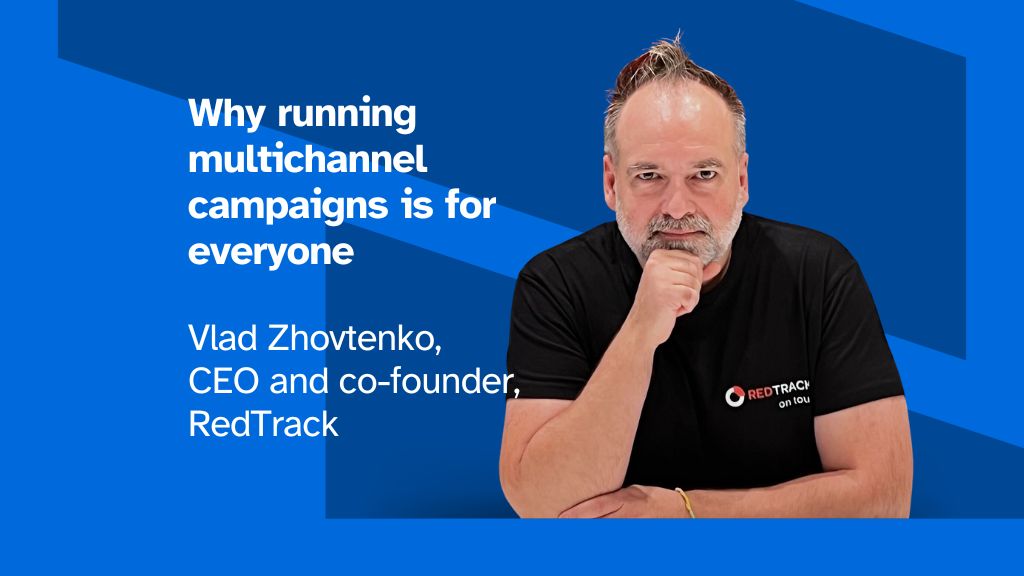by Vlad Zhovtenko, CEO and co-founder at RedTrack, the AI-driven analytics and automation platform for media buyers
SEO, socials, email, events, audio, video – there are so many ways in which companies can reach their audiences. For all marketers, this panoply of platforms, formats, and metrics is a major headache. Determining which channels to use is consistently noted as a top pain point in article after article.
What’s holding them back? Usually, it’s a combination of technology and time. It doesn’t matter whether you’ve got a fully staffed marketing department or you’re an entrepreneur doing it all yourself; your focus is on generating a return on your activities.
While multichannel campaigns can be a real pain, they can also drive significant rewards. Having that multichannel mindset is necessary for any marketer that wants to see where the most effective uses of budget are. Plus, there are ways to make introducing new channels to your marketing mix easier and more effective.
New channels equal more work
From a marketer’s perspective, a new channel means investing resources in setup, testing, optimization, and all the other processes needed to run effective campaigns. There are no guarantees of success.
Plus, a lot will depend on the maturity of the channel. Some, like Snapchat or BlueSky, don’t have the same inbuilt automation tools as other, more established platforms. That means more manual work, making new or untested channels less attractive.
However, avoiding channels in this manner not only overlooks potential audiences but also creates a new problem. If Facebook works for you and all your tools are set up to manage ads on that channel, you know what you’re dealing with, even if you see diminishing returns. But you might end up in a situation where your chosen channels aren’t performing as well as they used to, and you may not have the needed insights that could show if alternatives should be added.
Finding a way to overcome the unknown
And that’s the key – how do you overcome the unknown? It’s a bit of a vicious cycle: you don’t try new things because you don’t have any data to indicate what could work, but you don’t have any insights because you don’t try new things.
What’s needed is a way of obtaining evidence of what might happen if a new channel is activated – not generalized results based on anonymous surveys, but genuine insights that can inform planning.
This is where AI can help. If trained on other users’ data (with consent, of course), AI can provide insights required to help even those with little experience in a specific channel quickly understand what’s likely to work.
For example, a small coffee shop chain in the East Midlands with a limited budget and channel mix could leverage insights from others in their space. Based on shared data, they could see that TikTok is 30% of the media mix for other hospitality venues targeting a similar audience and that certain types of ads perform better than others. This helps the chain assess whether a channel is worth considering and reduces the risk of making avoidable mistakes.
Going from average to great with human and machine
That’s a key distinction between humans and machines – AI helps prevent those mistakes by aggregating data and providing automated insights. However, that shouldn’t be taken as a reason to trust what the machine says unquestioningly. It’s important to remember that any AI-generated output will only be as good as the data used to train the model. The results will probably end up focusing on certain averages. This can be enough to guide thinking on likely scenarios, but humans must get involved to take those insights, apply them to specific instances, and make them great.
This automated but guided approach needs to continue even when businesses invest in channels and automate their processes so that they can run multichannel campaigns. There are inherent risks in using any automated system because you’re giving up a degree of control. Humans need to remain the managers. They should monitor the system, understand the limits of the models being used, and intervene when necessary.
For example, say you use a system to automate when your Facebook campaigns run. If automation goes down, no one will stop your ads. Your budget keeps running, and if a rule fails to pause an underperforming ad or it increases your spend, you end up wasting money. So you need human oversight to manually switch ads on and off if that system goes down.
Multichannel campaigns for all
Digital marketing has brought down barriers to entry and increased businesses’ ability to connect with new audiences. Marketers should be looking at multichannel campaigns. However, the amount of choice and the corresponding uncertainty around performance can lead to missed opportunities. With the right support through AI and automation, even the smallest businesses can gather the insights they need to trial new routes to market.









